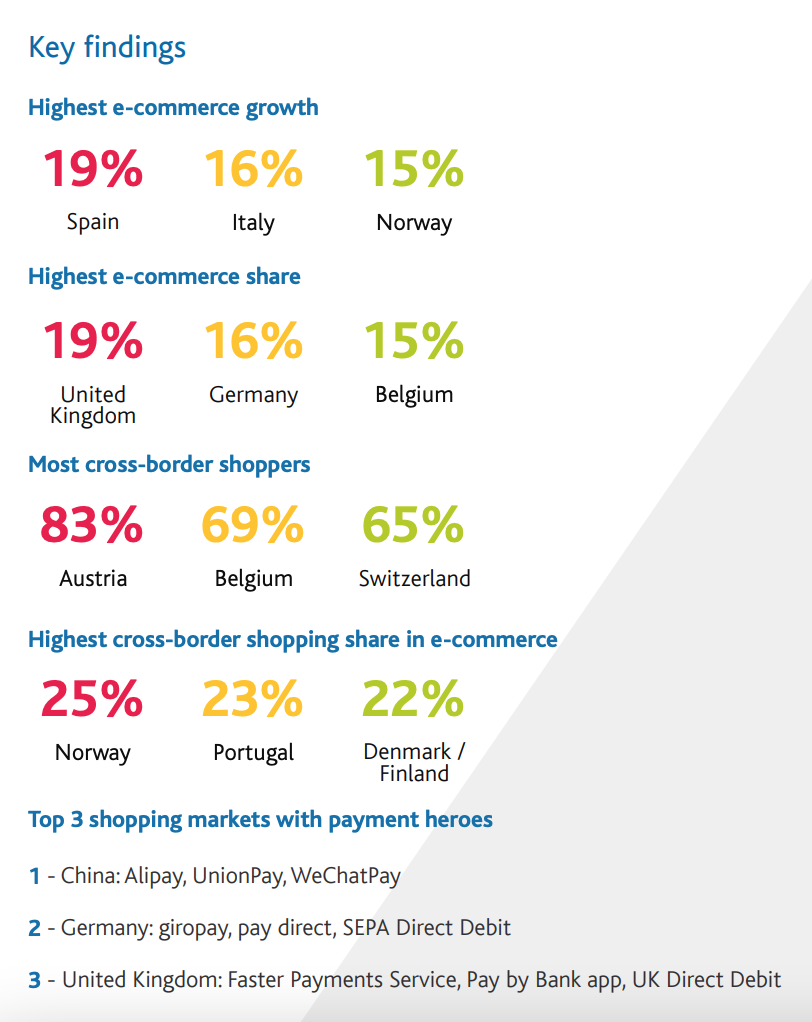In Europe, online shoppers are increasingly embracing cross-border e-commerce, with China, the UK and Germany emerging as the top three preferred shopping markets, a new report says.
In a new paper titled How Europe prefers to pay: E-Commerce Payment Report 2021, German business services firm Arvato and payment services provider PPRO look at the state of e-commerce in Europe and customers’ preferences.
According to the report, the COVID-19 pandemic has been a catalyst for consumer adoption of e-commerce with forecasts estimating an annual revenue growth of over 6% by 2025. In France, Germany and the UK, the three largest European markets, up to 80% of customers now carry out at least half of their shopping online.
In Europe, the UK, Germany and Belgium have the highest penetration rates with e-commerce making up 19%, 16% and 13% in the overall market, but Spain and Italy saw the strongest growth, with e-commerce activity rising 19% and 16%, respectively.
Customers in Austria, Belgium and Switzerland were find to be the most avid cross-border shoppers in the region, representing 83% of e-commerce customers in Austria, 69% in Belgium and 65% in Switzerland. China, Germany and the UK are the top three shopping markets for cross-border purchases.

E-commerce trends in Europe, Source: How Europe prefers to pay: E-Commerce Payment Report 2021, Arvato and PPRO, May 2021
These findings coincide with results from a recent global survey conducted by the International Post Corporation (IPC), a consortium of national postal service operators. The study, which surveyed more than 33,00 frequent online shoppers in 40 countries, found that 32% of cross-border shoppers purchased more from online retailers in other countries in 2020.
Cross-border shoppers purchased most often from China which attracted the most foreign shoppers – as they have for the past five years of the survey. Germany ranked second, attracting 14% of cross-border shoppers in 2020.

Country from which respondents made their last cross-border online purchase, 2020 vs. 2019, Source: International Post Corporation “Cross-Border E-commerce Shopper Survey 2020”, Feb 2021
The study found that Amazon is the most popular international retailer, followed by AliExpress, the Alibaba Group marketplace mostly used by Chinese retailers, EBay, and Wish, another marketplace that mostly features affordable goods from China.

Retailer from which respondents made their last cross-border online purchase, Source: International Post Corporation “Cross-Border E-commerce Shopper Survey 2020”, Feb 2021
A recent study by Forrester found that mobile devices are driving the boom in e-commerce. In 2020, mobile overtook desktop across Europe as the preferred shopping platform. More than half of online sales took place on a smartphone or tablet, accounting for EUR 123 billion in sales, the study found.
According to the European Parliamentary Research Service, the rise of mobile commerce (m-commerce) in the region will likely accelerate the adoption of mobile payment methods.
Currently, payment method for e-commerce purchases in Europe vary according to local preferences, but overall, cards are the preferred method across most markets, a 2018 JP Morgan survey found.
Card usage is particularly strong in wealthy, digitally advanced countries with high bank penetration such as Denmark (63.4% of e-commerce payments), Ireland (60%), and the UK (53%).
In Finland, Switzerland and the Netherlands, bank transfers are the primary payment method, while in Germany, customers tend to prefer open invoicing, where purchases are paid for once they have been received, as well as PayPal.
Featured image credit: Photo by PhotoMIX Company from Pexels
The post China, UK, Germany Among Top Shopping Markets for European E-Commerce Customers appeared first on Fintech Schweiz Digital Finance News - FintechNewsCH.
Comments